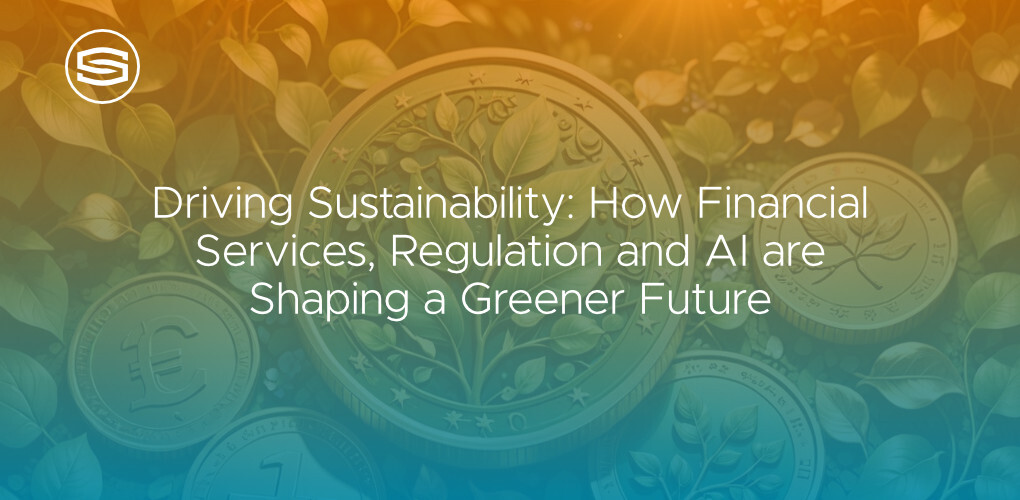
Insights & Opinions
Driving Sustainability: How Financial Services, Regulation, and AI are Shaping a Greener Future
Tue, 10 Dec 2024


We cannot ignore the essential role of financial services in transforming our society into a greener self, allowing the Earth to keep pace with everyone living on it. Much of the money in the economy flows in the directions that financial services set. So, if we want more sustainable investments, we must look at financial services.
In many discussions with financial services executives, I learned that regulation is overwhelming these days. It has become too much to fulfil. So, when we hosted a dinner with mainly asset managers and pension funds, I was surprised to hear the positive sentiment towards regulation.
I was also surprised by the engagement: even after 3 hours of discussions in the heart of Amsterdam, it seemed impossible to close the evening. That brought a lot of valuable food for thought that I didn’t want to keep for myself, obviously respecting Chatham House rules.
“Regulation is not static—it’s constantly evolving”
Before the dinner, I did my research because there is a lot out there regarding regulations, with a lot of abbreviations, and it can be messy because a lot of regulations affect each other. There is the CSRD (Corporate Sustainability Reporting Directive), but more specifically for finance, the SFDR (Sustainable Finance Disclosure Regulation). There is the EU Taxonomy and soon also the CSDDD (Corporate Sustainability Due Diligence Directive).
In addition to the multitude of regulations and directives, we also learned that most of them are not stable, adding to the complexity of complying with them. In the near future, biodiversity will become a more important reporting topic, and SMEs will also need to start reporting. Thus, financial institutions will face even bigger challenges and more work.
How do you keep pace with shifting interpretations and implementation requirements, and how do you maintain a single source of truth for future benchmarking? Because of these challenges, we are starting to talk more about “greenhushing” than greenwashing. Many organisations have become much more cautious about their efforts in the sustainable transition and have started to underplay sustainability achievements to avoid scrutiny. That is precisely what greenhushing is: the practice where organisations intentionally underplay or conceal their sustainability efforts and achievements to avoid public scrutiny, regulatory attention, or accusations of greenwashing.
Despite this, the sentiment in the room towards these regulations was positive. People praised the regulators for fostering accountability and distinguishing genuine ESG efforts from greenwashing. Part of the sentiment can also be explained by regulators' growing openness to dialogue, making the case for proactive engagement with the industry.
"Data quality is no longer an excuse—innovative ESG strategies demand forward-looking insights"
Banks will need to collect increasing amounts of data, consolidate it, and ensure reliable reporting, interpretation for product development, and validation for compliance reasons. Data forms the backbone of ESG-focused investment strategies. Several participants noted that the quality and granularity of raw ESG data vary significantly across regions and sectors. This disparity creates difficulties for global firms aiming to benchmark sustainability metrics. Additionally, validated sustainability data is often challenging to obtain within the required reporting timelines.
As explained before, all the reporting is seen as the start of future due diligence to compare financial institutions and their efforts over time. But what do you do when regulations and interpretations of those regulations change?
Data provides the evidence base for assessing risks, measuring impact, and aligning portfolios with sustainability goals. Yet, a key challenge lies in the reliance on backwards-looking data, which focuses on historical performance rather than future trends. As one expert observed, “The currently available data is all backward-looking. The key is to look at the future and consider how business models will change due to ESG factors.”
New, innovative approaches will be key to bridging that challenge because the old paradigm no longer fits our future risk calculations. That is where analytics and AI enter the game. The winning institutions will be the ones that can build solutions that generate actionable insights and predictions by combining historical data with emerging trends. This is a compliance exercise and one for risk and product development. After all, investment funds undergo the same evolution, where the past is no longer enough to predict future returns.
"AI isn’t here to replace us—it’s here to scale our impact and amplify our insights"
If you are still reading the article at this stage, you understand how all this affects a bank's back office, with ever-increasing compliance regulations and reporting. I guess you also know that this comes with an extra cost that financial institutions cannot afford, as customers don’t accept that these new activities are calculated in the price of the products and services they sign up for.
So banks need to be smart, and that is where AI comes in place. AI was identified as a transformative tool for addressing the limitations of traditional ESG data. Generative AI (GenAI) models can synthesise vast amounts of information to predict future outcomes, providing critical insights for investment decision-making. For example, AI can evaluate how a company’s operations might evolve under different regulatory scenarios or climate conditions. This capability enables firms to anticipate risks and align their portfolios with long-term sustainability objectives.
Participants emphasised the compatibility of AI with human expertise. For example, AI-generated insights must always include a human in the loop for validation. Personally, I expected AI to be used for reporting as well, but around the table, there was a consensus that automation is much better at doing that, with a reduced risk of mistakes. That also shows how the interpretation of AI evolved over time.
After the hype of AI, with many proof-of-concepts, boards of financial services companies are now closely following up on the expected returns. This makes it hard sometimes to make the business case for new AI initiatives, especially because the output depends on the data being used and the people using the tools. As one expert stated, “AI needs to reduce costs or show clear added value soon for investments to continue.” This pragmatic approach underscores the importance of aligning AI applications with tangible business outcomes.
Trust remains a critical factor in the adoption of AI. Transparency in how models are trained and deployed is essential for maintaining stakeholder confidence. Financial firms must ensure that their AI systems are explainable and traceable, enabling them to justify decisions to regulators, clients, and other stakeholders. One participant captured this sentiment with a simple blush test: “Can you explain your decision to your kids without being embarrassed?”
"Leadership in sustainability demands innovation, collaboration, and a readiness to embrace change"
The insights shared during the roundtable underscore the transformative potential of data-driven sustainability, regulatory alignment, and AI in financial services. And it was promising to hear that everyone was so favourable to contribute to that more sustainable future.
While challenges related to data quality, regulatory variability, and cultural resistance persist, they are not insurmountable. By leveraging innovative tools like AI and embracing a forward-looking approach to regulation and data management, the industry can position itself as a leader in sustainable finance.
The road ahead requires collaboration, transparency, and a willingness to adapt to an ever-changing landscape. With these principles as guiding lights, financial services firms can not only meet their sustainability goals but also drive meaningful impact on a global scale. At The Banking Scene, we cannot wait to contribute to the growing need for collaboration and dialogue.



